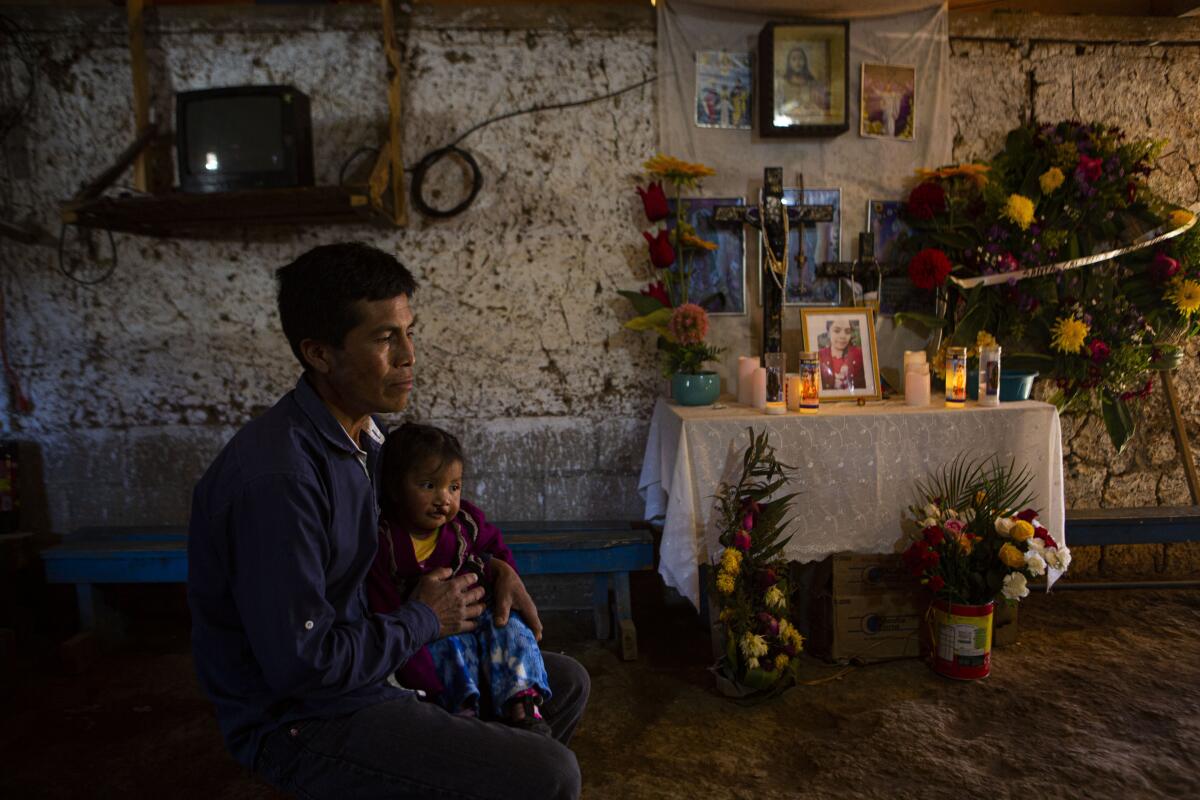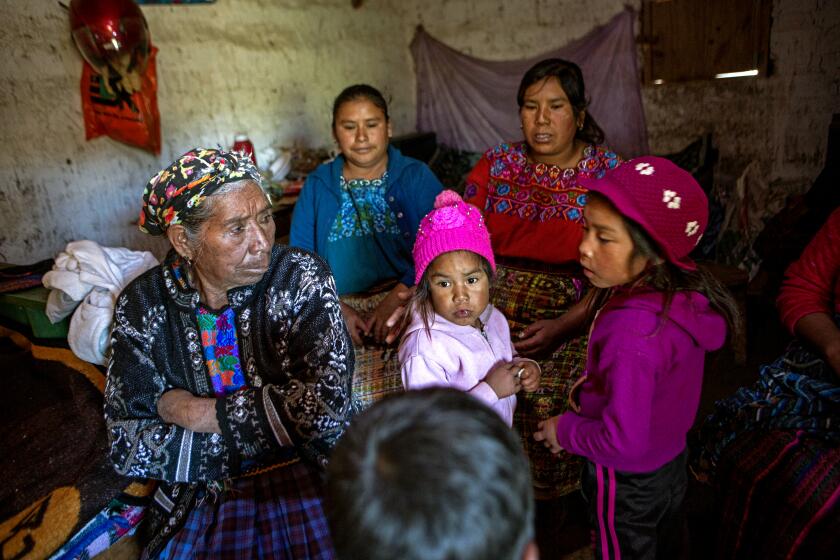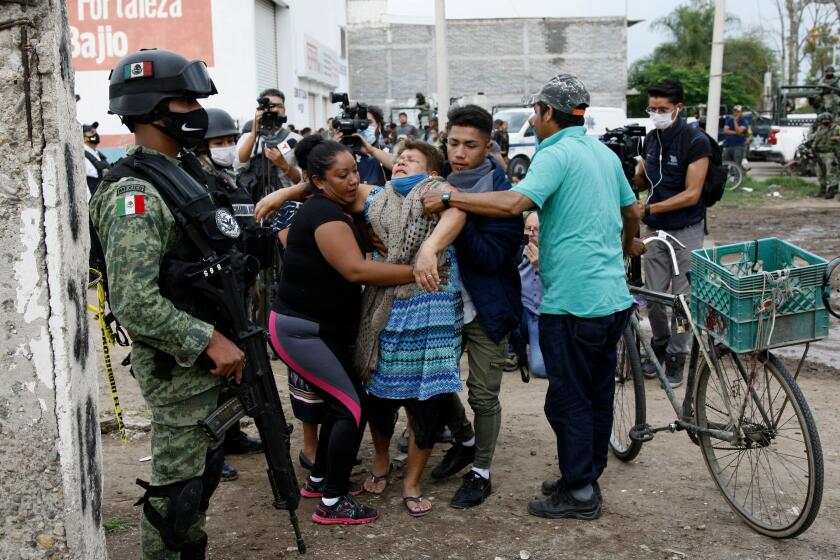A dozen state police officers are charged in massacre of 19 in Mexico

- Share via
CIUDAD VICTORIA, Mexico — A dozen state police officers were being questioned Wednesday following their arrests in connection with the killings of 19 people, including Guatemalan migrants, whose bodies were found shot and burned near the U.S. border late in January.
Tamaulipas state Atty. Gen. Irving Barrios Mojica announced Tuesday night that all 12 officers faced charges of homicide, abuse of authority and making false statements.
The killings revived memories of the gruesome 2010 massacre of 72 migrants near the town of San Fernando in the same gang-ridden state. Those killings were carried out by a drug cartel, but the Jan. 22 slayings allegedly were carried out by law enforcement.
“In the aforementioned acts of Jan. 22, at least 12 state police officers participated,” Barrios Mojica said.
The attorney general did not say what motive the officers might have had, though corrupt local and state police in Mexico are often in the pay of drug cartels.
Cartels in Mexico often charge migrant smugglers for crossing their territory, and kidnap or kill migrants whose smugglers have paid a rival gang.
The bodies were found piled in a charred pickup truck in Camargo, across the Rio Grande from Texas, in an area that has been bloodied for years by turf battles between the remnants of the Gulf cartel and the old Zetas cartel.
Another burned vehicle was found at the scene, and authorities say it had been seized by immigration officials in a raid that detained 66 migrants on their way to the U.S. The same vehicle had been reclaimed from immigration officials in December by a man who later was identified as one of the victims in the January attack.
Interior Secretary Olga Sánchez Cordero said Wednesday that immigration agents tied to the case had been fired, though she provided no details on their number or their alleged role.
“These violations of the rights of migrants are absolutely unacceptable,” Sánchez Cordero said. She said no member of the security forces or immigration authority was above the law.
Authorities have said four of the dead have been identified so far, two Guatemalans and two Mexicans. Their names have not been released by officials, but relatives of one of the dead Mexicans said he had worked as an immigrant trafficker.
Nineteen burned bodies are found in an area in northern Mexico near the U.S. border that has a long history of horrific violence against migrants.
Of the 19 bodies examined by experts, 16 were found to be males, one was confirmed as female and the two others were so badly burned that their gender had not yet been determined.
The forensic results confirmed the fears of families in a rural Indigenous farming community in Guatemala who have said they lost contact with 13 migrants as they traveled toward the United States.
Guatemala’s Foreign Affairs Ministry said late Tuesday that it was working closely with Mexican authorities. In a statement, it asked that “the full weight of law be applied to those responsible for such unfortunate events that have Guatemalan families mourning.”
The truck holding the bodies had 113 bullet impacts, but authorities were confused by the fact that almost no spent shell casings were found at the scene.
Initially, that led investigators to speculate the shootings may have taken place elsewhere, and the truck driven to the spot where it was set on fire.
But Barrios Mojica said the state police officers charged in the killings knew their shell casings might give them away, and so they probably picked them up.
Authorities suspect the assault was part of a fierce turf battle that has transformed industrial Guanajuato into one of Mexico’s deadliest states.
“There is growing force behind the hypothesis that the crime scene was altered, due to the absence of casings,” he said.
In describing the hours that led up to the killings, Barrios Mojica said the truck carrying the victims was apparently part of a larger convoy of vehicles transporting migrants from Guatemala and El Salvador to smuggle them across the U.S. border. He said the trucks also carried armed men to provide protection.
Barrios Mojica did not rule out that the reason for the killings may have been a dispute between drug gangs, which fight over territory and the right to charge migrant smugglers for passing through “their” territory.
The massacre is the latest chapter in Tamaulipas’ history of police corruption. Most towns and cities in the state saw their municipal police forces dissolved years ago, because officers were often in the pay of the cartels. A more professional state police force was supposed to be the answer, but that idea came crashing down with the arrests announced Tuesday.
Breaking News
Get breaking news, investigations, analysis and more signature journalism from the Los Angeles Times in your inbox.
You may occasionally receive promotional content from the Los Angeles Times.
Mexico’s National Immigration Institute has been plagued with corruption.
“We have had problems with many of the immigration officials with these types of rights violations and we have to recognize it to move forward,” Sánchez Cordero said.
A repeat of the 2010 massacre has long been one of the Mexican government’s worst nightmares.
In August 2010, Zetas cartel members stopped two tractor-trailers carrying dozens of mostly Central American migrants and took them to a ranch in the Tamaulipas town of San Fernando. After the migrants refused to work for the cartel, they were blindfolded, tied up on the floor and shot dead.
In 2019, President Andrés Manuel López Obrador said, “We do not want a repeat of horrendous, regrettable acts like San Fernando.”
Relatives of migrants from Guatemala’s province of San Marcos are so convinced that 13 of the 19 charred corpses were their loved ones that some of the families already erected traditional altars to the dead, with flowers and photographs.
Some of the relatives in Guatemala told of receiving calls from the migrant smuggler who took the group of 10 men and three women north, telling them their family members were dead. Relatives said they lost contact with them around Jan. 21.
More to Read
Sign up for Essential California
The most important California stories and recommendations in your inbox every morning.
You may occasionally receive promotional content from the Los Angeles Times.











